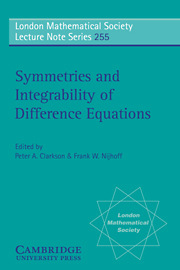Book contents
- Frontmatter
- Contents
- Preface
- List of Participants
- 1 Partial Difference Equations
- 2 Integrable Mappings
- 3 Discrete Geometry
- 4 Asymptotic Analysis
- 5 Discrete Painlevé Equations
- 6 Symmetries of Difference Equations
- 7 Numerical Methods and Miscellaneous
- 8 Cellular Automata
- 9 q-Special Functions and q-Difference Equations
- 10 Quantum Aspects and Yang-Baxter Equations
- Schrödinger equation on quantum homogeneous spaces
- Local Yang-Baxter relations associated with Hirota's discrete equation
- Some algebraic solutions of discrete equations from anticommuting variables
Some algebraic solutions of discrete equations from anticommuting variables
Published online by Cambridge University Press: 04 August 2010
- Frontmatter
- Contents
- Preface
- List of Participants
- 1 Partial Difference Equations
- 2 Integrable Mappings
- 3 Discrete Geometry
- 4 Asymptotic Analysis
- 5 Discrete Painlevé Equations
- 6 Symmetries of Difference Equations
- 7 Numerical Methods and Miscellaneous
- 8 Cellular Automata
- 9 q-Special Functions and q-Difference Equations
- 10 Quantum Aspects and Yang-Baxter Equations
- Schrödinger equation on quantum homogeneous spaces
- Local Yang-Baxter relations associated with Hirota's discrete equation
- Some algebraic solutions of discrete equations from anticommuting variables
Summary
Abstract
We describe specific solutions of some discrete-invariance equations. The equations are related the symmetries of the Yang-Baxter equations. The solutions are inspiredfrom the so-called free-fermions models of lattice statistical mechanics, and make useof anticommuting variables.
Introduction
Among the discrete equations subject to current study, many lead to the following problem: find the invariants of rational and rationally invertible transformations (see the other contributions to these proceedings and for instance). As an example, all of the discrete Painlevé equations presented in are invariance equations under birational transformations. The analysis of such equations often reduces to the analysis of the iterates of a mapping, and sometimes to the study of arborescent iterations.
It was noted in that the “integrability” of a mapping is related toits low complexity, measured for example by the rate of growth of the degree ofthe successive iterates.
We describe here a somewhat extreme case of low complexity: finite orbits. For rational transformations, finite orbits automatically provide algebraic invariant varieties. They are unfortunately not so easy to find: calculating the iterates of the transformations, just to write down the finiteness conditions for the orbits, is more than oftenbeyond reach. We will nevertheless produce solutions of the finiteness conditions. Onenovel feature of these solutions is that they are obtained through the use of anticommuting variables.
- Type
- Chapter
- Information
- Symmetries and Integrability of Difference Equations , pp. 410 - 419Publisher: Cambridge University PressPrint publication year: 1999

